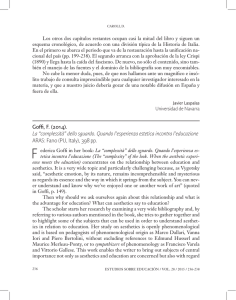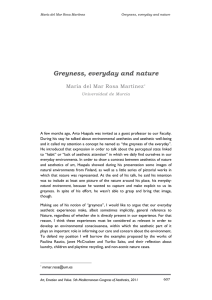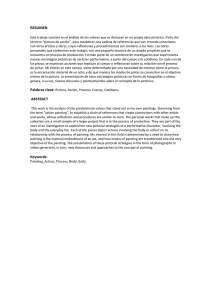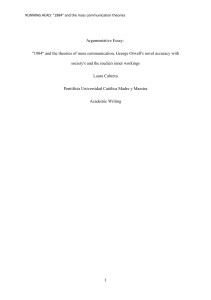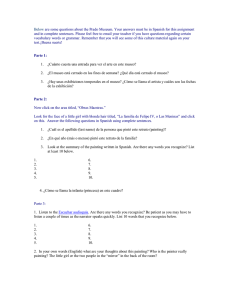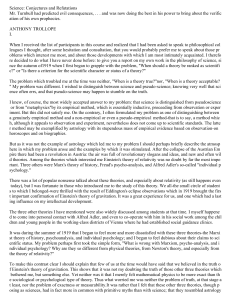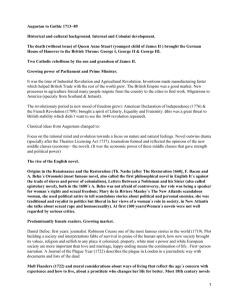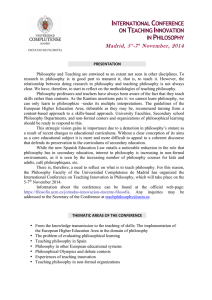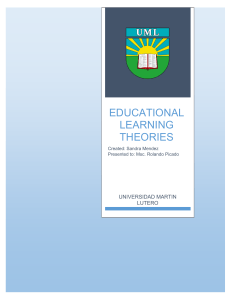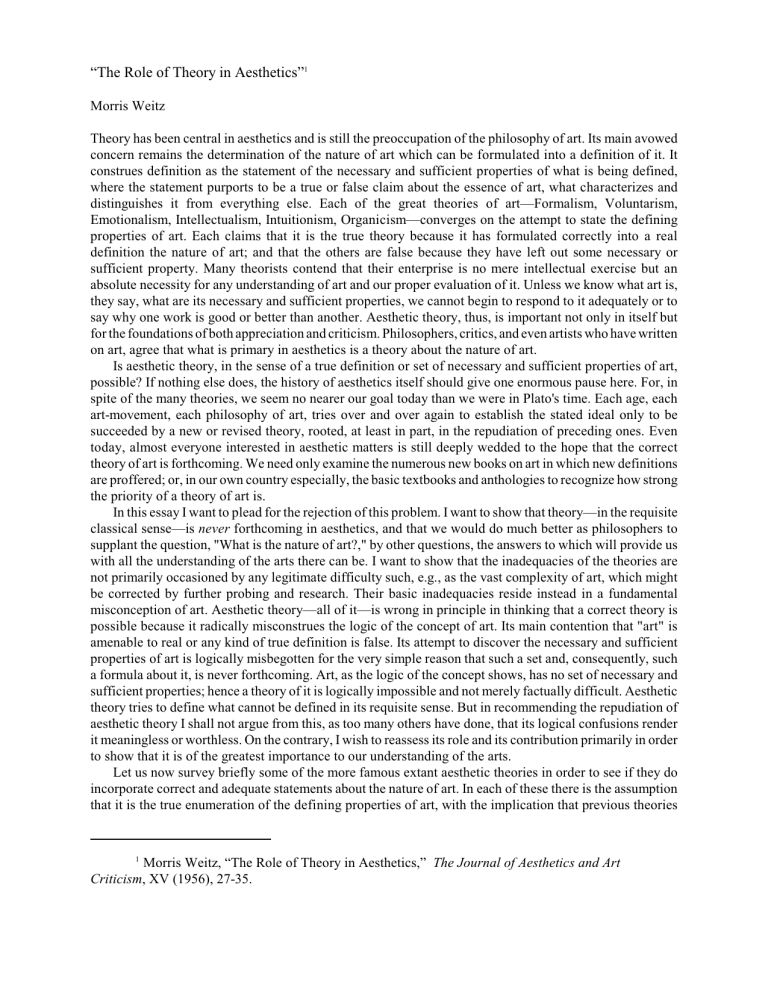
“The Role of Theory in Aesthetics”1 Morris Weitz Theory has been central in aesthetics and is still the preoccupation of the philosophy of art. Its main avowed concern remains the determination of the nature of art which can be formulated into a definition of it. It construes definition as the statement of the necessary and sufficient properties of what is being defined, where the statement purports to be a true or false claim about the essence of art, what characterizes and distinguishes it from everything else. Each of the great theories of art—Formalism, Voluntarism, Emotionalism, Intellectualism, Intuitionism, Organicism—converges on the attempt to state the defining properties of art. Each claims that it is the true theory because it has formulated correctly into a real definition the nature of art; and that the others are false because they have left out some necessary or sufficient property. Many theorists contend that their enterprise is no mere intellectual exercise but an absolute necessity for any understanding of art and our proper evaluation of it. Unless we know what art is, they say, what are its necessary and sufficient properties, we cannot begin to respond to it adequately or to say why one work is good or better than another. Aesthetic theory, thus, is important not only in itself but for the foundations of both appreciation and criticism. Philosophers, critics, and even artists who have written on art, agree that what is primary in aesthetics is a theory about the nature of art. Is aesthetic theory, in the sense of a true definition or set of necessary and sufficient properties of art, possible? If nothing else does, the history of aesthetics itself should give one enormous pause here. For, in spite of the many theories, we seem no nearer our goal today than we were in Plato's time. Each age, each art-movement, each philosophy of art, tries over and over again to establish the stated ideal only to be succeeded by a new or revised theory, rooted, at least in part, in the repudiation of preceding ones. Even today, almost everyone interested in aesthetic matters is still deeply wedded to the hope that the correct theory of art is forthcoming. We need only examine the numerous new books on art in which new definitions are proffered; or, in our own country especially, the basic textbooks and anthologies to recognize how strong the priority of a theory of art is. In this essay I want to plead for the rejection of this problem. I want to show that theory—in the requisite classical sense—is never forthcoming in aesthetics, and that we would do much better as philosophers to supplant the question, "What is the nature of art?," by other questions, the answers to which will provide us with all the understanding of the arts there can be. I want to show that the inadequacies of the theories are not primarily occasioned by any legitimate difficulty such, e.g., as the vast complexity of art, which might be corrected by further probing and research. Their basic inadequacies reside instead in a fundamental misconception of art. Aesthetic theory—all of it—is wrong in principle in thinking that a correct theory is possible because it radically misconstrues the logic of the concept of art. Its main contention that "art" is amenable to real or any kind of true definition is false. Its attempt to discover the necessary and sufficient properties of art is logically misbegotten for the very simple reason that such a set and, consequently, such a formula about it, is never forthcoming. Art, as the logic of the concept shows, has no set of necessary and sufficient properties; hence a theory of it is logically impossible and not merely factually difficult. Aesthetic theory tries to define what cannot be defined in its requisite sense. But in recommending the repudiation of aesthetic theory I shall not argue from this, as too many others have done, that its logical confusions render it meaningless or worthless. On the contrary, I wish to reassess its role and its contribution primarily in order to show that it is of the greatest importance to our understanding of the arts. Let us now survey briefly some of the more famous extant aesthetic theories in order to see if they do incorporate correct and adequate statements about the nature of art. In each of these there is the assumption that it is the true enumeration of the defining properties of art, with the implication that previous theories 1 Morris Weitz, “The Role of Theory in Aesthetics,” The Journal of Aesthetics and Art Criticism, XV (1956), 27-35. Philosophy of Art “The Role of Theory in Aesthetics”—2 have stressed wrong definitions. Thus, to begin with, consider a famous version of Formalist theory, that propounded by Bell and Fry. It is true that they speak mostly of painting in their writings but both assert that what they find in that art can be generalized for what is "art" in the others as well. The essence of painting, they maintain, are the plastic elements in relation. Its defining property is significant form, i.e., certain combinations of lines, colors, shapes, volumes—everything on the canvas except the representational elements—which evoke a unique response to such combinations. Painting is definable as plastic organization. The nature of art, what it really is, so their theory goes, is a unique combination of certain elements (the specifiable plastic ones) in their relations. Anything which is art is an instance of significant form; and anything which is not art has no such form. To this the Emotionalist replies that the truly essential property of art has been left out. Tolstoy, Ducasse, or any of the advocates of this theory, find that the requisite defining property is not significant form but rather the expression of emotion in some sensuous public medium. Without projection of emotion into some piece of stone or words or sounds, etc., there can be no art. Art is really such embodiment. It is this that uniquely characterizes art, and any true, real definition of it, contained in some adequate theory of art, must so state it. The Intuitionist disclaims both emotion and form as defining properties. In Croce's version, for example, art is identified not with some physical, public object but with a specific creative, cognitive and spiritual art. Art is really a first stage of knowledge in which certain human beings (artists) bring their images and intuitions into lyrical clarification or expression. As such, it is an awareness, non-conceptual in character, of the unique individuality of things; and since it exists below the level of conceptualization or action, it is without scientific or moral content. Croce singles out as the defining essence of art this first stage of spiritual life and advances its identification with art as a philosophically true theory or definition. The Organicist says to all of this that art is really a class of organic wholes consisting of distinguishable, albeit inseparable, elements in their causally efficacious relations which are presented in some sensuous medium. In A. C. Bradley, in piece-meal versions of it in literary criticism, or in my own generalized adaptation of it in my Philosophy of the Arts, what is claimed is that anything which is a work of art is in its nature a unique complex of interrelated parts—in painting, for example, lines, colors, volumes, subjects, etc., all interacting upon one another on a paint surface of some sort. Certainly, at one time at least it seemed to me that this organic theory constituted the one true and real definition of art. My final example is the most interesting of all, logically speaking. This is the Voluntarist theory of Parker. In his writings on art, Parker persistently calls into question the traditional simple-minded definitions of aesthetics. “The assumption underlying every philosophy of art is the existence of some common nature present in all the arts."1 "All the so popular brief definitions of art—'significant form,' 'expression,' 'intuition,' 'objectified pleasure'—are fallacious, either because, while true of art, they are also true of much that is not art, and hence fail to differentiate art from other things; or else because they neglect some essential aspect of art."2 But instead of inveighing against the attempt at definition of art itself, Parker insists that what is needed is a complex definition rather than a simple one. “The definition of art must therefore be in terms of a complex of characteristics. Failure to recognize this has been the fault of all the well-known definitions."3 His own version of Voluntarism is the theory that art is essentially three things: embodiment of wishes and desires imaginatively satisfied, language, which characterizes the public medium of art, and harmony, which unifies the language with the layers of imaginative projections. Thus, for Parker, it is a true definition to say of art that it is “. . . the provision of satisfaction through the imagination, social significance, and harmony. I am claiming that nothing except works of art possesses all three of these marks."4 Now, all of these sample theories are inadequate in many different ways. Each purports to be a complete statement about the defining features of all works of art and yet each of them leaves out something which the others take to be central. Some are circular, e.g., the Bell-Fry theory of art as significant form which is defined in part in terms of our response to significant form. Some of them, in their search for necessary and sufficient properties, emphasize too few properties, like (again) the Bell-Fry definition, which leaves out subject-representation in painting, or the Croce theory, which omits inclusion of the very important feature Philosophy of Art “The Role of Theory in Aesthetics”—3 of the public, physical character, say, of architecture. Others are too general and cover objects that are not art as well as works of art. Organicism is surely such a view since it can be applied to any causal unity in the natural world as well as to art.5 Still others rest on dubious principles, e.g., Parker's claim that art embodies imaginative satisfactions, rather than real ones; or Croce's assertion that there is nonconceptual knowledge. Consequently, even if art has one set of necessary and sufficient properties, none of the theories we have noted, or, for that matter, no aesthetic theory yet proposed, has enumerated that set to the satisfaction of all concerned. Then there is a different sort of difficulty. As real definitions, these theories are supposed to be factual reports on art. If they are, may we not ask, Are they empirical and open to verification or falsification? For example, what would confirm or disconfirm the theory that art is significant form or embodiment of emotion or creative synthesis of images? There does not even seem to be a hint of the kind of evidence which might be forthcoming to test these theories; and indeed one wonders if they are perhaps honorific definitions of "art," that is, proposed redefinitions in terms of some chosen conditions for applying the concept of art, and not true or false reports on the essential properties of art at all. But all these criticisms of traditional aesthetic theories—that they are circular, incomplete, untestable, pseudo-factual, disguised proposals to change the meaning of concepts—have been made before. My intention is to go beyond these to make a much more fundamental criticism, namely, that aesthetic theory is a logically vain attempt to define what cannot be defined, to state the necessary and sufficient properties of that which has no necessary and sufficient properties, to conceive the concept of art as closed when its very use reveals and demands its openness. The problem with which we must begin is not "What is art?," but "What sort of concept is 'art'?" Indeed, the root problem of philosophy itself is to explain the relation between the employment of certain kinds of concepts and the conditions under which they can be correctly applied. If. I may paraphrase Wittgenstein, we must not ask, What is the nature of any philosophical x?, or even, according to the semanticist, What does "x" mean?, a transformation that leads to the disastrous interpretation of "art" as a name for some specifiable class of objects; but rather, What is the use or employment of "x"? What does "x" do in the language? This, I take it, is the initial question, the begin-all if not the end-all of any philosophical problem and solution. Thus, in aesthetics, our first problem is the elucidation of the actual employment of the concept of art, to give a logical description of the actual functioning of the concept, including a description of the conditions under which we correctly use it or its correlates. My model in this type of logical description or philosophy derives from Wittgenstein. It is also he who, in his refutation of philosophical theorizing in the sense of constructing definitions of philosophical entities, has furnished contemporary aesthetics with a starting point for any future progress. In his new work, Philosophicallnvestigations,6 Wittgenstein raises as an illustrative question, What is a game? The traditional philosophical, theoretical answer would be in terms of some exhaustive set of properties common to an games. To this Wittgenstein says, let us consider what we call "games": "I mean board-games, card-games, ball-games, Olympic games, and so on. What is common to them all?—Don't say: 'there must be something common, or they would not be called "games'" but look and see whether there is anything common to all.—For if you look at them you will not see something that is common to all, but similarities, relationships, and a whole series of them at that. ... " Card games are like board games in some respects but not in others. Not all games are amusing, nor is there always winning or losing or competition. Some games resemble others in some respects—that is all. What we find are no necessary and sufficient properties, only "a complicated network of similarities overlapping and crisscrossing," such that we can say of games that they form a family with family resemblances and no common trait. If one asks what a game is, we pick out sample games, describe these, and add, "This and similar things are called 'games.' " This is all we need to say and indeed all any of us knows about games. Knowing what a game is is not knowing some real definition or theory but being able Philosophy of Art “The Role of Theory in Aesthetics”—4 to recognize and explain games and to decide which among imaginary and new examples would or would not be called "games." The problem of the nature of art is like that of the nature of games, at least in these respects: If we actually look and see what it is that we call "art," we will also find no common properties—only strands of similarities. Knowing what art is is not apprehending some manifest or latent essence but being able to recognize, describe, and explain those things we call "art" in virtue of these similarities. But the basic resemblance between these concepts is their open texture. In elucidating them, certain (paradigm) cases can be given, about which there can be no question as to their being correctly described as "art" or "game," but no exhaustive set of cases can be given. I can list some cases and some conditions under which I can apply correctly the concept of art but I cannot list all of them, for the all-important reason that unforeseeable or novel conditions are always forthcoming or envisageable. A concept is open if its conditions of application are emendable and corrigible; i.e., if a situation or case can be imagined or secured which would call for some sort of decision on our part to extend the use of the concept to cover this, or to close the concept and invent a new one to deal with the new case and its new property. If necessary and sufficient conditions for the application of a concept can be stated, the concept is a closed one. But this can happen only in logic or mathematics where concepts are constructed and completely defined. It cannot occur with empirically-descriptive and normative concepts unless we arbitrarily close them by stipulating the ranges of their uses. I can illustrate this open character of "art" best by examples drawn from its sub-concepts. Consider questions like "Is Dos Passos' U.S.A. a novel?," "Is V. Woolf's To the Lighthouse a novel?" "Is Joyce's Finnegan's Wake a novel?" On the traditional view, these are construed as factual problems to be answered yes or no in accordance with the presence or absence of defining properties. But certainly this is not how any of these questions is answered. Once it arises, as it has many times in the development of the novel from Richardson to Joyce (e.g., "Is Gide's The School for Wives a novel or a diary?"), what is at stake is no factual analysis concerning necessary and sufficient properties but a decision as to whether the work under examination is similar in certain respects to other works, already called "novels," and consequently warrants the extension of the concept to cover the new case. The new work is narrative, fictional, contains character delineation and dialogue but (say) it has no regular time-sequence in the plot or is interspersed with actual newspaper reports. It is like recognized novels, A, B, C ... , in some respects but not like them in others. But then neither were B and C like A in some respects when it was decided to extend the concept applied to A to B and C. Because work N + 1 (the brand new Work) is like A, B, C, ... N in certain respects—has strands of similarity to them—the concept is extended and a new phase of the novel engendered. "Is N + I a nove!?," then, is no factual, but rather a decision problem, where the verdict turns on whether or not we enlarge our set of conditions for applying the concept. What is true of the novel is, I think, true of every sub-concept of art: "tragedy," "comedy," "painting," "opera," etc., of "art" itself. No "Is X a novel, painting, opera, work of art, etc.?" question allows of a definitive answer in the sense of a factual yes or no report. "Is this collage a painting or not?" does not rest on any set of necessary and sufficient properties of painting but on whether we decideas we did!—to extend "painting" to cover this case. "Art," itself, is an open concept. New conditions (cases) have constantly arisen and will undoubtedly constantly arise; new art forms, new movements will emerge, which will demand decisions on the part of those interested, usually professional critics, as to whether the concept should be extended or not. Aestheticians may lay down similarity conditions but never necessary and sufficient ones for the correct application of the concept. With "art" its conditions of application can never be exhaustively enumerated since new cases can always be envisaged or created by artists, or even nature, which would call for a decision on someone's part to extend or to close the old or to invent a new concept. (E.g., "It's not a sculpture, it's a mobile.") What I am arguing, then, is that the very expansive, adventurous character of art, its ever-present changes and novel creations, makes it logically impossible to ensure any set of defining properties. We can, of course, Philosophy of Art “The Role of Theory in Aesthetics”—5 choose to close the concept. But to do this with "art" or "tragedy" or "portraiture," etc., is ludicrous since it forecloses on the very conditions of creativity in the arts. Of Course there are legitimate and serviceable closed concepts in art. But these are always those whose boundaries of conditions have been drawn for a special purpose. Consider the difference, for example, between "tragedy" and "( extant) Greek tragcdy. " The first is open and must remain so to allow for the possibility of new conditions, e.g., a play in which the hero is not noble or fallen or in which there is no hero but other elements that are like those of plays we already call "tragedy." The second is closed. The plays it can be applied to, the conditions under which it can be correctly used are all in, once the boundary, "Greek," is drawn. Here the critic can work out a theory or real definition in which he lists the common properties at least of the extant Greek tragedies. Aristotle's definition, false as it is as a theory of all the plays of Aeschylus, Sophocles, and Euripides, since it does not cover some of them,7 properly called "tragedies," can be interpreted as a real (albeit incorrect) definition of this closed concept; although it can also be, as it unfortunately has been, conceived as a purported real definition of "tragedy," in which case it suffers from the logical mistake of trying to define what cannot be defined—of trying to squeeze what is an open concept into an honorific formula for a closed concept. What is supremely important, if the critic is not to become muddled, is to get absolutely clear about the way in which he conceives his concepts; otherwise he goes from the problem of trying to define "tragedy," etc., to an arbitrary closing of the concept in terms of certain preferred conditions or characteristics which he sums up in some linguistic recommendation that he mistakenly thinks is a real definition of the open concept. Thus, many critics and aestheticians ask, "What is tragedy?," choose a class of samples for which they may give a true account of its common properties, and then go on to construe this account of the chosen closed class as a true definition or theory of the whole open class of tragedy. This, I think, is the logical mechanism of most of the so-called theories of the sub-concepts of art: "tragedy," "comedy," "novel," etc. In effect, this whole procedure, subtly deceptive as it is, amounts to a transformation of correct criteria for recognizing members of certain legitimately closed classes of works of art into recommended criteria for evaluating any putative member of the class. The primary task of aesthetics is not to seek a theory but to elucidate the concept of art. Specifically, it is to describe the conditions under which we employ the concept correctly. Definition, reconstruction, patterns of analysis are out of place here since they distort and add nothing to our understanding of art. What, then, is the logic of "X is a work of art"? As we actually use the concept, "Art" is both descriptive (like "chair") and evaluative (like "good"); i.e., we sometimes say, "This is a work of art," to describe something and we sometimes say it to evaluate something. Neither use surprises anyone. What, first, is the logic of "X is a work of art," when it is a descriptive utterance? What are the conditions under which we would be making such an utterance correctly? There are no necessary and sufficient conditions but there are the strands of similarity conditions, i.e., bundles of properties, none of which need be present but most of which are, when we describe things as works of art. I shall call these the "criteria of recognition" of works of art. All of these have served as the defining criteria of the individual traditional theories of art; so we are already familiar with them. Thus, mostly, when we describe something as a work of art, we do so under the conditions of there being present some sort of artifact, made by human skill, ingenuity, and imagination, which embodies in its sensuous, public medium—stone, wood, sounds, words, etc.—certain distinguishable elements and relations. Special theorists would add conditions like satisfaction of wishes, objectification or expression of emotion, some act of empathy, and so on; but these latter conditions seem to be quite adventitious, present to some but not to other spectators when things are described as works of art. "X is a work of art and contains no emotion, expression, act of empathy, satisfaction, etc.," is perfectly good sense and may frequently be true. "X is a work of art and ... was made by no one," or " ... exists only in the mind and not in any publicly observable thing," or ". . . was made by accident when he spilled the paint on the canvas," in each case of which a normal condition is denied, are Philosophy of Art “The Role of Theory in Aesthetics”—6 also sensible and capable of being true in certain circumstances. None of the criteria of recognition is a defining one, either necessary or sufficient, because we can sometimes assert of something that it is a work of art and go on to deny anyone of these conditions, even the one which has traditionally been taken to be basic, namely, that of being an artifact: Consider, "This piece of driftwood is a lovely piece of sculpture." Thus, to say of anything that it is a work of art is to commit oneself to the presence of some of these conditions. One would scarcely describe X as a work of art if X were not an artifact, or a collection of elements sensuously presented in a medium, or a product of human skill, and so on. If none of the conditions were present, if there were no criteria present for recognizing something as a work of art, we would not describe it as one. But, even so, no one of these or any collection of them is either necessary or sufficient. The elucidation of the descriptive use of "Art" creates little difficulty. But the elucidation of the evaluative use does. For many, especially theorists, "This is a work of art" does more than describe; it also praises. Its conditions of utterance, therefore, include certain preferred properties or characteristics of art. I shall call these "criteria of evaluation." Consider a typical example of this evaluative use, the view according to which to say of something that it is a work of art is to imply that it is a successful harmonization of elements. Many of the honorific definitions of art and its sub-concepts are of this form. What is at stake here is that "Art" is construed as an evaluative term which is either identified with its criterion or justified in terms of it. "Art" is defined in terms of its evaluative property, e.g., successful harmonization. On such a view, to say "X is a work of art" is (1) to say something which is taken to mean "X is a successful harmonization" (e.g., "Art is significant form") or (2) to say something praiseworthy on the basis of its successful .harmonization. Theorists are never clear whether it is (1) or (2) which is being put forward. Most of them, concerned as they are with this evaluative use, formulate (2), i.e., that feature of art that makes it art in the praise-sense, and then go on to state (1), i.e., the definition of "Art" in terms of its art-making feature. And this is clearly to confuse the conditions under which we say something evaluatively with the meaning of what we say. "This is a work of art," said evaluatively, cannot mean "This is a successful harmonization of elements"—except by stipulation—but at most is said in virtue of the art-making property, which is taken as a (the) criterion of "Art," when "Art" is employed to assess. "This is a work of art," used evaluatively, serves to praise and not to affirm the reason why it is said. The evaluative use of "Art," although distinct from the conditions of its use, relates in a very intimate way to these conditions. For, in every instance of "This is a work of art" (used to praise), what happens is that the criterion of evaluation (e.g., successful harmonization) for the employment of the concept of art is converted into a criterion of recognition. This is why, on its evaluative use, "This is a work of art" implies "This has P," where "P" is some chosen art-making property. Thus, if one chooses to employ "Art" evaluatively, as many do, so that "This is a work of art and not (aesthetically) good" makes no sense, he uses "Art" in such a way that he refuses to call anything a work of art unless it embodies his criterion of excellence. There is nothing wrong with the evaluative use; in fact, there is good reason for using "Art" to praise. But what cannot be maintained is that theories of the evaluative use of "Art" are true and real definitions of the necessary and sufficient properties of art. Instead they are honorific definitions, pure and simple, in which "Art" has been redefined in terms of chosen criteria. But what makes them—these honorific definitions—so supremely valuable is not their disguised linguistic recommendations; rather it is the debates over the reasons for changing the criteria of the concept of art which are built into the definitions. In each of the great theories of art, whether correctly understood as honorific definitions or incorrectly accepted as real definitions, what is of the utmost importance are the reasons proffered in the argument for the respective theory, that is, the reasons given for the chosen or preferred criterion of excellence and evaluation. It is this perennial debate over these criteria of evaluation which makes the history of aesthetic theory the important study it is. The value of each of the theories resides in its attempt to state and to justify certain criteria which are either neglected or distorted by previous theories. Look at the Bell-Fry theory again. Of course, "Art is significant form" cannot be accepted as a true, real definition of art; and most certainly it actually functions in their aesthetics as a redefinition of art in Philosophy of Art “The Role of Theory in Aesthetics”—7 terms of the chosen condition of significant form. But what gives it its aesthetic importance is what lies behind the formula: In an age in which literary and representational elements have become paramount in painting, return to the plastic ones since these are indigenous to painting. Thus, the role of the theory is not to define anything but to use the definitional form, almost epigrammatically, to pin-point a crucial recommendation to turn our attention once again to the plastic elements in painting. Once we, as philosophers, understand this distinction between the formula and what lies behind it, it behooves us to deal generously with the traditional theories of art; because incorporated in everyone of them is a debate over and argument for emphasizing or centering upon some particular feature of art which has been neglected or perverted. If we take the aesthetic theories literally, as we have seen, they all fail; but if we reconstrue them, in terms of their function and point, as serious and argued-for recommendations to concentrate on certain criteria of excellence in art, we shall see that aesthetic theory is far from worthless. Indeed, it becomes as central as anything in aesthetics, in our understanding of art, for it teaches us what to look for and how to look at it in art. What is central and must be articulated in all the theories are their debates over the reasons for excellence in art—debates over emotional depth, profound truths, natural beauty, exactitude, freshness of treatment, and so on, as criteria of evaluation—the whole of which converges on the perennial problem of what makes a work of art good. To understand the role of aesthetic theory is not to conceive it as definition, logically doomed to failure, but to read it as summaries of seriously made recommendations to attend in certain ways to certain features of art. Notes 1. D. Parker, "The Nature of Art," reprinted in E. Vivas and M. Krieger, The Problems of Aesthetics (N.Y., 1953), p. 90. 2. Ibid., pp. 93-94. 3. Ibid., p. 94. 4. Ibid., p. 104. 5. See M. Macdonald's review of my Philosophy of the Arts, Mind, Oct. 1951, pp. 561-564, for a brilliant discussion of this objection to the Organic theory. 6. L. Wittgenstein, Philosophical Investigations (Oxford, 1953), tr. E. Anscombe; see esp. Part I, Sec. 6575. All quotations are from these sections. 7. See H. D. F. Kitto, Greek Tragedy (London, 1939), on this point.
